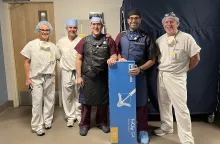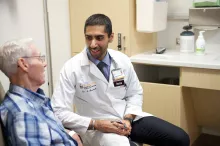Tricuspid Valve Repair and Replacement
- For all other requests:
- 1-800-777-8442
University of Iowa Heart and Vascular Center cardiac surgeons and interventional cardiologists offer the full spectrum of care for tricuspid valve regurgitation, including the latest minimally invasive tricuspid valve repair and replacement procedures. These procedures offer less risk, faster recovery, and less pain.
We’ll bring together a team of specialists to create a customized treatment plan for you. Our goal is to decrease your symptoms and boost your energy.
Our approach to tricuspid valve repair and replacement
The heart and vascular center structural heart and heart valve disease program is a national leader in tricuspid valve repair. Our specialists have advanced training in minimally invasive heart valve repair and replacement:
- Our center is the only one in Iowa that provides a full range of minimally invasive tricuspid valve repair and replacement options.
- Our team has performed more of these procedures than anyone else in the state.
- We offer the most advanced and cutting-edge treatments and therapies, using the latest technologies to provide the highest quality of care available.
Minimally invasive tricuspid valve repair and replacement
Your care team will assess your valve function with an echocardiogram and other tests.
If your tricuspid valve doesn’t close tightly
If your valve doesn’t close tightly, blood will flow backward into the right atrium and interfere with your heart function. This is known as tricuspid valve regurgitation.
Mild regurgitation may need only regular monitoring by your cardiologist. Moderate regurgitation may be treated with prescription medication.
Severe regurgitation can damage your heart and lead to heart failure. If you need valve repair, your care team will choose the procedure that best suits your unique anatomy and overall health.
Minimally invasive procedures we offer include:
- Clip technology: Our structural heart physicians have the most experience in the state using valve clip technology to repair the tricuspid valve in appropriate cases. This treatment is an option for people with severe valve regurgitation who have been told they are high risk and don’t qualify for surgery or have been unsuccessful with other therapies.
If your tricuspid valve is narrowed
If your valve is narrowed, blood is prevented from returning into the right atrium from the right ventricle. This is known as tricuspid valve stenosis. Procedures we offer include:
- Percutaneous balloon valvuloplasty: A deflated balloon is inserted into the valve through a catheter. Once in position, it’s inflated to widen the valve. Our interventional cardiologists were the first in Iowa to perform this procedure and have the most experience with it.
If your previously replaced tricuspid valve or surgical annuloplasty ring is failing
If you’ve already had your tricuspid valve replaced with an animal tissue (bioprosthetic) valve, the new valve will likely need to be replaced after 10 to 15 years. Similarly, if you already have a surgical annuloplasty ring, it might fail. Our team has expertise in minimally invasive procedures to replace failing valves and rings:
- Transcatheter valve replacement: Similar to TAVR. Your cardiologist will use a catheter to place a new valve inside the failing valve (valve-in-valve replacement) or ring (valve-in-ring).
How minimally invasive tricuspid valve repair or replacement works
During your procedure
Minimally invasive tricuspid valve procedures are done under general anesthesia, so you’ll be asleep during your procedure. Here’s what will happen:
- Your interventional cardiologist will make a small incision in a vein near your groin and insert a tube called a catheter into the incision.
- The catheter will be threaded through your blood vessels to your heart. When the catheter reaches the right spot, your cardiologist will guide the repair device or new valve through the tube.
- When the device or valve is properly placed and working, the catheter will be removed from your leg and the incision closed.
After your procedure
Here’s what you can expect when you wake up after your procedure:
- Depending on your overall health, you could recover in the hospital for up to five days.
- If you’ve been experiencing fatigue, shortness of breath, or other symptoms, you should begin feeling better very soon after your procedure.
- After you get home, you’ll need to limit your physical activity for about a month.
Alternatives to tricuspid valve repair or replacement
If you have mild or moderate regurgitation, your care team may choose to treat it with medication that eases strain on your heart. You could be prescribed medications that include:
- ACE inhibitors that relax your veins and arteries to lower your blood pressure
- Antiarrhythmics that maintain your heart rhythm
- Blood thinners to prevent blood clots
- Diuretics to help you get rid of excess fluid buildup
Severe regurgitation sometimes accompanies other heart conditions that require repair using open heart surgery. Your care team may decide to repair or replace your tricuspid valve during that procedure. Open surgery on the tricuspid valve is rarely performed on its own.
Our Care Team
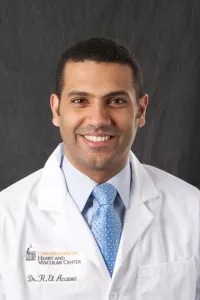


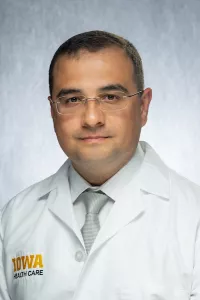



- Angela Kipp, RN, BSN
- Erin Walsh, RN, BSN
Have you been diagnosed with tricuspid valve regurgitation or stenosis?
Locations and Offices
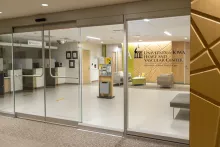
Related News
